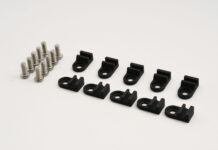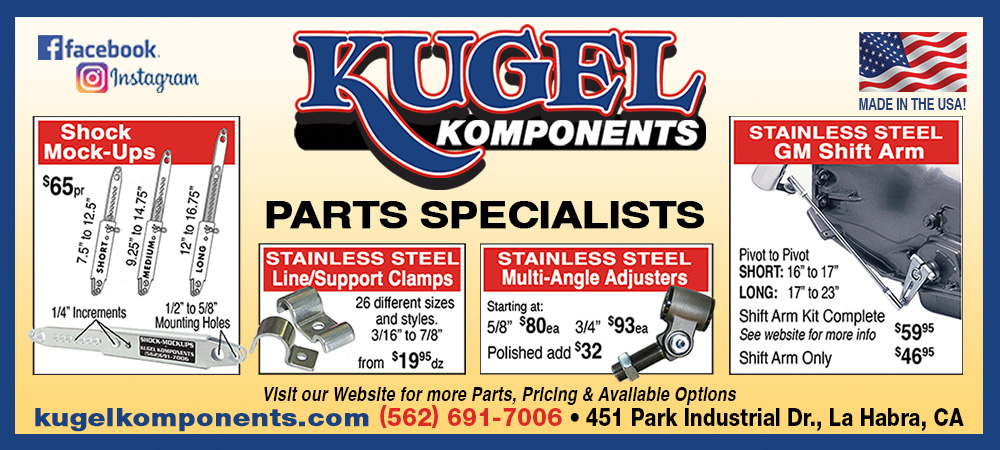A Simple Piston Ring Test That Produced Some Amazing Results
By Jeff Smith – Photography by the Author
The old Hollywood adage was “you can’t be too rich or too thin.” While Hollywood prefers to live in the land of fantasy, the last part of that recommendation holds some truth when it comes to making horsepower with internal combustion engines. The guys at Total Seal have been telling us for years that there’s hidden horsepower in most engines if you bother to lighten up the ring package, but there have always been skeptics.
Not long ago, Lake Speed Jr. was performing an engine bearing test at Shaver Racing Engines in Torrance, California, and we offered to follow along. This test had nothing to do with piston rings, but in the middle of the process of switching bearings in the 383ci small-block Chevy that is the shop’s test mule, an interesting incident occurred that led us directly to this story.
We were watching Shaver’s engine technician Keith Chrisco disassemble the connecting rod cap to change the bearings. As he removed the rod cap and pushed the piston down slightly (the engine was upside down on the engine stand with the heads in place) the piston slid down the bore and only stopped when it contacted the head. We’ve performed more than our share of engine builds and we’d never had a piston do that. This immediately prompted a question to Chrisco. “Stop right there. I just watched that piston slide down the bore all by itself. What rings are you using?”
Chrisco laughed and said, “You’ve never used thin rings before have you? Total Seal asked us to test them in this engine. I think there’s an A-B comparison of them on the dyno somewhere.” At this point, Speed Jr. entered the engine room and overheard the conversation. He pulled up a photo on his phone of the comparison of the two sets of Total Seal rings they had tested.

There were several points concerning these two dyno curves that were of significant interest to us. We’ve reproduced that graph for this story, but the information surrounding this data is what makes it interesting. But before we get into all the numbers, let’s set the stage by describing the test engine.
This 383ci small-block Chevy is Shaver’s test mule. It was never intended to make massive horsepower or torque. Instead its primary objective was and continues to be a completely reliable engine where all kinds of parts could be tested with no worry about reliability. This engine was built to be mercilessly abused for hours with an emphasis on delivering reliable and repeatable numbers.
To this end, engine builder Chrisco started with a World Products iron 4.00-inch bore block and fitted it with a Scat 3.75-inch stroker forged steel crank with 350ci main bearing journal dimensions. Bearings were supplied by Clevite working with a set of Scat 6.0-inch connecting rods to a set of JE Sportsman 4032 alloy forged pistons. These pistons came with a 16cc dish to work with Edelbrock E-Tec 200 aluminum cylinder heads to keep the compression ratio pump-gas compatible at 9.8:1.
In this particular configuration, the Shaver crew was using a flat tappet, single-pattern Comp Magnum hydraulic camshaft with conservative specs of 236 degrees of duration at 0.050 with just 0.490-inch lift. Shaver combined this cam with Comp lifters, pushrods, and 1.5:1 roller rockers to keep the valvetrain under control. For the induction side of things, they selected an Edelbrock Performer RPM intake and a mild, 600-cfm Edelbrock AVS carburetor with 1 ¾-inch dyno headers for the exhaust.

For the baseline part of this test, the JE off-the-shelf pistons were machined for a set of 1/16-inch rings. Total Seal spec’d a set of 0.9mm AP Ultra-Thin rings with the appropriate spacers to make up the difference in the vertical height of the rings. To put this in perspective, a 1/16-inch ring measures 0.0625-inch thick while a 0.9mm ring is significantly (43 percent) thinner at only 0.0354 inch. Engineers call this axial thickness.
The thin ring concept is certainly garnering a lot of favor both in production engines as well as in the performance arena. Early 2000-era LS engines were fitted with a 1.5mm (0.0585-inch) top ring that GM trimmed to 1.2 mm (0.0468 inch) for the LS7. The new Gen V LT5 427 engines are fitted with a 0.8mm (0.0312-inch) top ring. Thinner rings offer multiple advantages, starting with the contact point of the ring to the cylinder wall.
What we’re talking about here is the outward tension that is required to help seal the ring face to the cylinder wall. Even a relatively “thin” ring, such as a 1/16-inch small-block Chevy piston ring, plants a very wide footprint on the cylinder wall. This large contact area demands a substantial amount of force to push the ring outward to the cylinder wall. Total Seal has a very expensive machine that can measure this radial (outward) tension–expressed in pound-force (lb-f). As an example, a 1/16-inch Total Seal top ring will exert a tension of 5.7 lb-f.

A thinner ring reduces this contact patch and as a result, this also reduces the force required to load the ring with the appropriate outward tension. Think of this as pounds of force per square inch. Logically, as we reduce the square inches of contact face with a thinner ring, less force is required to create the same load on the thinner ring. Much of this force is created by the width of the ring looking at it from the top of the cylinder–often referred to as radial thickness. As the ring’s axial thickness is reduced, so is the radial thickness–reducing the outward tension.
Next, let’s sprinkle into this friction equation the fact that research by Chevron Phillips Chemical reveals that within a piston-driven internal combustion engine, the greatest single point of friction within the engine is between the piston rings and the cylinder wall. Chevron’s research places this at 45 percent of total power loss due to friction. So clearly anything that will reduce the piston ring friction should be worth some horsepower and torque.
Let’s take a look at the baseline 0.9mm ring package. The top ring is part of Total Seal’s Advanced Profile (AP) Ultra-Thin ring set. The 0.9mm top ring is a 440 stainless steel material that uses this advanced profiling technique. This smaller ring reduces friction while its thinner cross section allows it to seal more efficiently to the cylinder wall and to the ring groove in order to minimize cylinder pressure leakage. Not only is the ring thinner in terms of its contact face, but the body of the ring is also narrower as viewed from the top.

The SAE offers a simple formula to determine this radial wall thickness: bore diameter / 22. So for a typical 4.030-inch bore diameter, this would make the ring’s standard radial thickness 0.183-inch. Speed Jr. tells us that this formula is now changing and that thinner rings are now also radially thinner as well. Reducing this width reduces ring weight and also makes the ring more flexible as long as there is proper back side clearance. If the back clearance is excessive, it can reduce the ring’s effectiveness. This is why if using an axial spacer to use a thinner ring on a piston, it would be best to also include a radial spacer to reduce this clearance.
The second (below the top) ring in this test is a ductile iron material that uses a specific Napier design that is tapered to help squeegee the remaining oil off the cylinder wall and improves upon the scraper idea with a small pocket on the back side of the ring that captures and channels the oil away from the ring. The oil ring package selected was a standard tension package that was not changed during this test.
Now that we’ve identified the players, we can move to the actual baseline test. “Dyno” Don MacAskill is Shaver’s dyno operator who, with help from Speed Jr. installed the 383 on Shaver’s SuperFlow dyno. The baseline numbers are nothing notable. These numbers represent the power made by the engine already equipped with the Total Seal 0.9mm top and second rings. These are even thinner than a production LS3 engine and radically thinner than a 1/16-inch ring that is often used in street engines.

The test we stumbled upon was to switch to one of Total Seal’s more race-oriented low-friction rings using a thinner 0.7mm (0.0273-inch) thickness Diamond Finish top and second rings. Going to these yet thinner rings required a spacer to make up the difference in thickness in the ring grooves since the pistons were not changed. The cylinders were also not honed or even cleaned in between tests.
As you can see from the dyno graph and the accompanying dyno numbers, this piston ring swap produced some amazing results. The average torque improvement penciled out to more than 16 lb-ft from 3,100 to 6,000 rpm. Note how the friction reduction improves the power across the entire torque curve. This is roughly a 4 percent gain in overall power across the entire rpm band. There are very few changes in the internal combustion engine (short of power adders) that will generate this type of improvement. Note that the highest gains were achieved just after peak torque where the greatest increase in cylinder pressure sealing occurred, improving torque by 21 lb-ft.
We can attribute this power gain to a combination of improved ring seal and reduced friction. This is especially surprising because the change in thickness was almost insignificant. But the numbers don’t lie. Imagine if the Shaver’s crew had started a baseline with its original 1/16-inch ring package. The power gains would have been even greater.

When we first shared some of this information with engine enthusiasts, an often-asked question concerns durability. Many think that a thinner ring will wear much quicker. The reality is that because the radial or outward tension is reduced, this creates a similar ring loading. Of course, more efficient sealing means more cylinder pressure and subsequent loading of the top ring. However, ring loading most often wears the ring land on the piston and not necessarily the ring. This makes sense since the ring material is iron or steel while the piston is aluminum. Offsetting this additional load is improved lubricants and harder ring face coatings that can more than offset any additional wear. Clearly, thinner rings are capable of extended life in production engines that routinely now see mileage use well beyond 150,000 miles.

The takeaway from this story is that a seemingly small change in engine configuration uncovered a major improvement in performance. What is not covered but is worthy of more attention is the importance of proper cylinder wall honing preparation especially when working with thinner ring packages. If your goal is to build your next engine better than the previous one, then attention to tiny details like ring packages and cylinder sealing are among the best ways to achieve more power.
TQ1 and HP1 – 0.9mm ring package
TQ2 and HP2 is 0.7mm ring package
Power Chart
| RPM | TQ1 | HP1 | TQ2 | HP2 | TQ Diff | HP Diff |
| 3100 | 449 | 265 | 468 | 276 | +19 | +11 |
| 3200 | 456 | 278 | 474 | 289 | +18 | +11 |
| 3300 | 460 | 289 | 478 | 300 | +14 | +11 |
| 3400 | 464 | 300 | 481 | 312 | +17 | +12 |
| 3500 | 466 | 310 | 484 | 322 | +18 | +12 |
| 3600 | 468 | 321 | 486 | 333 | +18 | +12 |
| 3700 | 471 | 332 | 487 | 343 | +16 | +11 |
| 3800 | 473 | 343 | 489 | 354 | +15 | +11 |
| 3900 | 475 | 353 | 491 | 365 | +16 | +12 |
| 4000 | 475 | 362 | 492 | 375 | +17 | +13 |
| 4100 | 474 | 370 | 492 | 384 | +18 | +14 |
| 4200 | 469 | 375 | 490 | 392 | +21 | +17 |
| 4300 | 465 | 381 | 486 | 397 | +21 | +16 |
| 4400 | 463 | 388 | 481 | 403 | +18 | +15 |
| 4500 | 462 | 396 | 479 | 410 | +17 | +14 |
| 4600 | 461 | 404 | 478 | 419 | +17 | +15 |
| 4700 | 460 | 412 | 478 | 428 | +18 | +16 |
| 4800 | 459 | 419 | 477 | 436 | +18 | +17 |
| 4900 | 457 | 426 | 475 | 443 | +18 | +17 |
| 5000 | 455 | 433 | 472 | 449 | +17 | +16 |
| 5100 | 452 | 439 | 467 | 454 | +15 | +15 |
| 5200 | 448 | 443 | 463 | 458 | +15 | +15 |
| 5300 | 443 | 447 | 457 | 462 | +14 | +15 |
| 5400 | 437 | 449 | 451 | 464 | +14 | +15 |
| 5500 | 431 | 451 | 445 | 466 | +14 | +15 |
| 5600 | 424 | 452 | 438 | 467 | +14 | +15 |
| 5700 | 417 | 453 | 431 | 468 | +14 | +15 |
| 5800 | 409 | 451 | 423 | 467 | +14 | +16 |
| 5900 | 399 | 448 | 413 | 464 | +14 | +16 |
| 6000 | 389 | 445 | 402 | 459 | +13 | +14 |
| Peak | 475 | 453 | 492 | 468 | +21 | +17 |
| Avg | 451.2 | 387.8 | 467.6 | 401.9 | +16.4 | +14.1 |
Ring Thickness Chart
| Ring
Thickness |
Decimal
Equivalent |
| 5/64 | 0.0781 |
| 1/16 | 0.0625 |
| 1.5mm | 0.0590 |
| 1.2mm | 0.0472 |
| 1.0mm | 0.0393 |
| 0.8mm | 0.0354 |
| 0.7mm | 0.0275 |
Contacts
JE Pistons
(714) 898-9764
jepistons.com
Scat
(310) 370-5501
scatcrankshafts.com
Shaver Racing Engines
(310) 370-6941
shaverengines.com
Total Seal
(623) 587-7400
totalseal.com


























